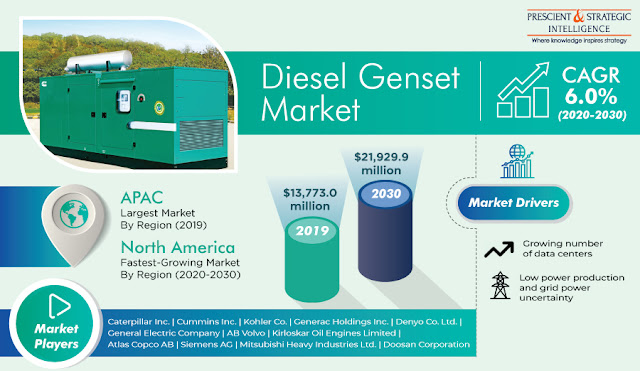
Why Can the World Not Live without Diesel Generators?
For any mechanized process, energy is needed, and for all non-engine objects, the energy comes from electricity. Thus, with the world’s population set to reach 10.9 billion by 2100 from 7.7 billion in 2019, as per the World Population Prospects 2019 report of the United Nations (UN), the demand for electricity is going to keep burgeoning. There is only one problem, especially in developing countries: electricity production is already insufficient to meet the needs of the present population, and the demand–supply gap is only expected to widen. Similarly, in several developed countries, the power grid infrastructure is aging, thereby leading to substantial transmission losses.
Therefore, with the rising demand for electricity and aging transmission infrastructure, the diesel genset market is predicted to generate $21,929.9 million by 2030 compared to $13,773.0 million in 2019. According to P&S Intelligence, the value increase would be at a CAGR of 6% over the forecast period (2020–2030). This is because generators have long been the best way to produce electricity in places lacking a regular grid connection or those that witness frequent outages.
The growing population is leading to the rapid urbanization and industrialization, which are essentially why the electricity demand is increasing. The rising number of people is driving the construction of houses, factories, and a host of commercial settings, such as hospitals, schools, transit hubs, shopping centers, office complexes, and utility centers. Generators are a must during construction, while they are also required for uninterrupted power supply after the units have been commissioned. The need for uninterrupted power is especially dire in essential spaces, such as hospitals and factories.
During 2014–2019 (historical period), Asia-Pacific held the largest share in the diesel generator set market, in terms of both value and volume. This is attributed to the expanding telecommunications infrastructure, growing industrial production, and increasing requirement for power backup in houses and large residential pockets. Initiatives including Make in India, Making Indonesia 4.0, and Made in China 2025 are driving the construction of factories, thus driving the demand for diesel generators during and after the development process.
Hence, genset sales will continue being high with the rising population and power transmission uncertainties in developing and developed countries both.
Source: www.psmarketresearch.com
Comments